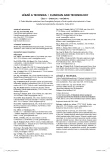The posibility of computational modeling usage in the specific Dynamic Hip Screw complications analysis
Authors:
Maroš Hrubina 1,2; Zdeněk Horák 3; Miroslav Skoták 1; Radek Bartoška 4; Valér Džupa 4
Authors‘ workplace:
Ortopedické oddělení Nemocnice Pelhřimov, Pelhřimov
1; Katedra lékařských a humanitních oborů Kladno, Fakulta biomedicínského inženýrství ČVUT v Praze, Kladno
2; Laboratoř biomechaniky člověka, Fakulta strojní, ČVUT v Praze, Praha
3; Ortopedicko-traumatologická klinika 3. LFUK a FNKV v Praze, Praha
4
Published in:
Lékař a technika - Clinician and Technology No. 1, 2012, 42, 26-32
Overview
The aim of the study was to determine the relationship between the specific complications and the dynamic hip screw (DHS) placement in the femoral neck with relation to finite element method analysis. The implant associated specific complications are very diverse. We evaluated 336 dynamic hip screw osteosyntheses for pertrochanteric fractures in 324 patients. The program ABAQUS 6.9 was utilized for the development of the finite element model of the femur. Analyses were performed in 5 modeled situations corresponding to the screw location. Complication rate within the group of patients was 10% in general, with a reoperation rate of 4%. The highest risk of for an implant failure was associated with a location of the screw in the upper third of the neck. The finite element model analysis confirms our clinical experiences, when the optimal placement for a dynamic hip screw is in the middle third of the femoral neck. The technical mistake during the operation almost always leads to the implant failure with the need for the reoperation.
Keywords:
dynamic hip screw, finite element method, specific complications
Sources
1. Amrichová, J., Hrubina, M., Pangrác, J.: Permanentní močový katétr jako rizikový faktor vzniku urologických komplikací po TEP kyčelního kloubu – retrospektivní analýza. Urol. Praxi, 12 (2011), pp. 315-318.
2. Báča, V., Horák, Z.: Comparison of Isotropic and Orthotropic Material Property Assignments on Femoral Finite Element Models under Two Loading Conditions. Med Eng Phys., 29 (2007), pp. 935.
3. Báča, V., Horák, Z., Mikulenka, P., Džupa, V.: Comparison of an Inhomogeneous Orthotropic and Isotropic Material Models used for FE Analyses. Med Eng Phys., 30 (2008), pp. 924-930.
4. Báča, V., Kachlík, D.: Muskulo-ligamentózní aparát proximálního femuru v kontextu pertrochanterických zlomenin – anatomická studie. In Polák, Š., Pospíšilová, V., Varga I. (Eds): Morfológia v súčasnosti. Bratislava, Univerzita Komenského, 2007, pp.108-114.
5. Báča, V., Kachlík, D., Horák, Z., Stingl, J.: The Course of Osteons in the Compact Bone of the Human Proximal Femur with Clinical and Biomechanical Significance. Surg Radiol Anat., 29 (2007), pp. 201-207.
6. Barton, T.M., Gleeson, R., Topliss, C., Greenwood, R., Harries, W.J., Chesser, T.S.J.: A Comparison of the Long Gama Nail with the Sliding Hip Screw for the Treatment of AO/OTA 31-A2 Fractures of the Proximal Part of the Femur. J Bone Jt. Surg., 92A (2010), pp. 792-798.
7. Bartoníček, J., Douša, P., Skála-Rosenbaum, J., Košťál, R.: Trochanterické zlomeniny – souborný referát. Úraz. Chir., 10 (2002), pp. 13-24.
8. Baumgaertner, M.R., Curtin, S.L., Lindskog, D.M., Keggi, J.M.: The Value of the Tip-Apex Distance in Predicting Failure of Fixation of Peritrochanteric Fractures of the Hip. J Bone Jt. Surg., 77A (1995), pp. 1058-1064.
9. Birnbaum, K., Parndorf, T.: Finite Element Model of the Proximal Femur under Consideration of the Hip Centralizing Forces of the Iliotibial Tract. Clin. Biomech., 26 (2011), pp. 58-64.
10. Bonnaire, F., Lein, T., Bula, P.: Trochanteric Femoral Fractures: Anatomy, Biomechanics and Choice of Implant. Unfallchirurg. 114 (2011), pp. 491-500.
11. Džupa, V., Bartoníček, J., Skála-Rosenbaum, J., Přikazský, J.: Úmrtí pacientů se zlomeninou proximálního femuru v průběhu prvního roku po úrazu. Acta Chir. Orthop. Traum. Čech., 69 (2002), pp. 39-44.
12. Hoffmann, R., Haas, N.P., Femur, Proximal. In: Rüedi, T.P., Buckley, R.E., Moran, C.G. (Eds): AO Principles of Fracture Management. New York, Thieme 2007, pp. 751-765.
13. Hrubina, M., Skoták, M., Běhounek, J.: Komplikace operační léčby zlomenin proximálního femuru metodou DHS. Acta Chir. Orthop. Traum. Čech., 77 (2010), pp. 395-401.
14. Hrubina, M., Skoták, M., Běhounek, J.: Komplikace osteosyntézy zlomenin proximálního femuru DHS dlahou. Sborník přednášek a posterů, XII. Národní kongres ČSOT 2008, Praha, Galén 2008, pp. 122.
15. Hsueh, K.K., Fang, C.K., Chen, C.M., Su, Y.P., Wu, H.F., Chiu, F.Y.: Risk Factors in Cutout of Sliding Hip Screw in Intertrochanteric Fractures: an Evaluation of 937 Patients. Int Orthop., 34 (2010), pp. 1273-1276.
16. Ito, M., Nakata, T., Nishida, A., Uetani, M.: Age-related Changes in Bone Density, Geometry and Biomechanical Properties of the Proximal Femur: CT-based 3D Hip Structure Analysis in Normal Postmenopausal Women. Bone., 48 (2011), pp. 627-630.
17. Krischak, G., Dűrselen, L., Röderer, G.: Treatment of Peritrochanteric Fractures. Biomechanical Considerations. Unfallchirurg, 114 (2011), pp. 485-490.
18. Oestern, H.J., Gänsslen, A.:The Use of Blade Plate and Dynamic Screw Plate Osteosynthesis. Orthopäde., 39 (2010), pp. 160-170.
19. Pervez, H., Parker, M.J.: Dynamic Hip Screw: does Side make a Difference? Effects of Clockwise Torque on the Right and Left DHS. Injury, 31 (2000), pp. 697-699.
20. Skála-Rosenbaum, J., Bartoníček, J., Říha, D., Waldauf, P., Džupa, V.: Single-Centre Study of Hip Fractures in Prague, Czech Republic, 1997-2007. Int Orthop., 35 (2011), pp. 587-593.
21. Skoták, M., Běhounek, J., Krumpl, O.: Řešení pertrochanterických zlomenin proximálního femuru 130 st. dlahou – dlouhodobé výsledky. Acta Chir. Orthop. Traum. Čech., 66 (1999), pp. 336-341.
Labels
BiomedicineArticle was published in
The Clinician and Technology Journal

2012 Issue 1
Most read in this issue
- Intrakraniální tlak a jeho identifikační možnosti při léčbě kraniocerebrálního poranění
- Assessment of suitability of Excimer laser in treating onychomycosis
- Biophysical principles of photoacoustic tomography
- Resonance methods of measurement viscoelasticity of biological structures
